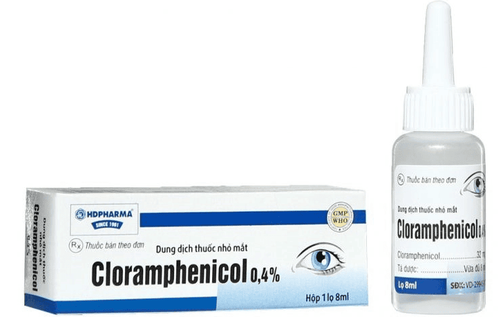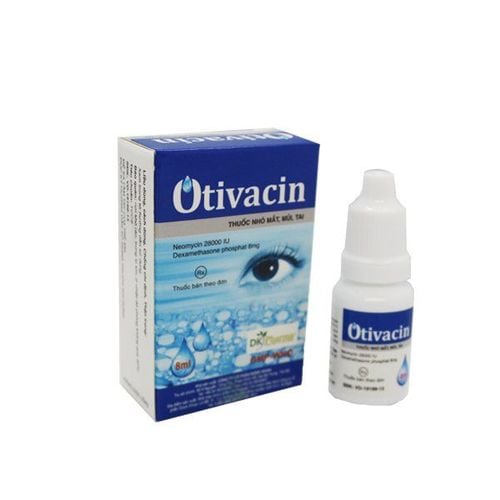This is an automatically translated article.
Agicloram is a drug in the treatment of eyes, ears - nose - throat, severe infections caused by sensitive bacteria. To better understand the composition, usage and uses of Agicloram, please read the following article.
1. What is Agicloram?
Agicloram medicine contains the main ingredient is Chloramphenicol, manufactured by Agimexpharm Pharmaceutical Joint Stock Company- Vietnam.
Pharmaceutical name: Agichloram drug. Ingredients: Chloramphenicol. Group of drugs: Belongs to the group of drugs for the treatment of eyes and ears - nose - throat. Dosage form: Capsule form. Packing: Packed in a box of 10 blisters x 10 tablets, 20 blisters x 10 tablets or a box of 1 HD plastic bottle containing 100 capsules. Registration number: VD-14219-11.
2. What disease does Agichloram treat?
Chloramphenicol is highly effective in bacteriostatic, but can kill bacteria at high concentrations or with highly sensitive bacteria. On the other hand, it also inhibits protein synthesis in susceptible bacteria through binding to the 50S ribosomal corpuscle. The drug also shares the same site of action with Lincomycin, Erythromycin, Oleandomycin, Clindamycin and Troleandomycin. Not only that, chloramphenicol also inhibits protein synthesis in rapidly proliferating mammalian cells. It causes bone marrow depression and may not be reversible.
Chloramphenicol contains immunosuppressive activity when given systemically before antigenic stimulation of the body. However, antibody response is unlikely to be significantly affected when chloramphenicol is administered post-antigen.
In addition, the drug has no effect on Staphylococcus aureus, Shigella flexneri, Escherichia coli, Enterobacter spp, Streptococcus pneumoniae, Salmonella typhi and has little effect on fungi.
Thanks to the above mechanisms, the drug Agicloram is effective in cases such as:
Infections in the anterior part of the eye, eyelid and lacrimal gland. Prevention of infection before and after surgery, chemical burns or other burns. Trachoma and eye shingles. In case it is necessary to irrigate the tear drainage system for the purpose of treatment or prevention. Severe infections caused by susceptible bacteria, meningitis and other infections caused by Haemophilus influenzae in cases where the antibiotics Gentamicin, Aminopenicillin and some 3rd generation Cephalosporins are ineffective or are contraindicated. Infection caused by Rickettsia when Tetracycline cannot be used.
3. Dosage and how to use Agicloram
For adults: Use 1-2 tablets/time, use 4 times a day.
For young children: Use 50mg/kg body weight/day, divided into 4 times/day.
In case of drug overdose can lead to some symptoms such as: Anemia, metabolic acidosis, hypotension, hypothermia. In this case, the patient should be treated symptomatically after gastric lavage.
4. Notes when using the drug Agicloram
4.1. Agicloram is contraindicated in the following cases:
Do not use Agicloram in patients with a history of hypersensitivity or toxic reactions due to the drug. Do not use the drug for women who are pregnant or women who are pregnant. Do not use the drug for patients with acute porphyria. Do not use Agicloram for the purpose of treating common infections or for cases not specified such as: Flu, colds, throat infections or as a prophylactic drug. 4.2. Side effects of Agicloram Undesirable side effects of Agicloram can be very serious, especially long-term or repeated treatment should be avoided. The most serious side effect is non-regenerative, irreversible anemia caused by bone marrow failure.
Common (incidence greater than 1/100):
Skin: Skin rash. Digestive system: Causes nausea, vomiting, diarrhea. Uncommon (incidence 1/1000): Blood: Causes thrombocytopenia, leukopenia, anemia with reticulocytosis, all of the above symptoms are reversible. Skin: Urticaria. Other side effects: Hypersensitivity reactions. Rare:
Body as a whole: Headache. Blood: Pancytopenia, agranulocytosis, non-regenerative anemia (ratio 1/10000 - 1/40000). Nervous system: Peripheral polyneuritis, optic neuritis, eye muscle paralysis, confusion. Other side effects: Gray syndrome in neonates and infants under 2 weeks of age (risk of high doses). When detecting the above-mentioned side effects or showing symptoms that are suspected to be side effects not listed above, the patient should immediately notify the doctor, medical staff for safe and timely treatment. time.
4.3. Chloramphenicol drug interactions can prolong the plasma half-life and increase the effect of Phenytoin, Dicumarol, Chlorpropamide and Tolbutamide by inhibiting the activity of Microsomal enzymes.
Phenobarbital, Rifampicin have the ability to reduce the concentration of Chloramphenicol in the blood plasma. In addition, Chloramphenicol also slows down the response of iron, folic acid, vitamin B12 preparations.
4.4. Precautions for use During the use of the drug, patients may experience serious reactions, even death, in cases of using Chloramphenicol at the reported dose. Therefore, patients treated with Chloramphenicol should be taken in a hospital for appropriate tests and clinical examination by a qualified physician. Treatment should be discontinued immediately if leukopenia, reticulocyte and platelet counts, anemia or other hematologic abnormalities are observed with chloramphenicol. The results of peripheral blood tests cannot be relied on to assess whether irreversible bone marrow suppression and non-regenerative anemia may occur. Chloramphenicol therapy should be discontinued immediately if optic or peripheral neuritis occurs. As with other antibiotics, use may cause overgrowth of susceptible bacteria, including fungi. If this is the case, it should be treated with appropriate therapy. Particular caution should be exercised when administering the drug to patients with impaired renal and/or hepatic function, and the dose should be reduced proportionally. For pregnant women, the safety of chloramphenicol therapy has not been established in this population. Chloramphenicol can readily cross the fetus and fetal plasma concentrations may be 30-80% of the concurrent maternal plasma concentrations. Therefore, do not use the drug for pregnant women who are close to the time of delivery or labor to avoid affecting the fetus. Reports indicate that Chloramphenicol is distributed into breast milk, so caution should be exercised during lactation to avoid toxic effects on the infant. The article has provided information about the composition, uses of Agicloram and other special notes. The drug should only be used when prescribed and supervised by a specialist to ensure its effectiveness and safety for the patient. Absolutely do not arbitrarily buy Agicloram to treat at home because it will encounter adverse side effects.













